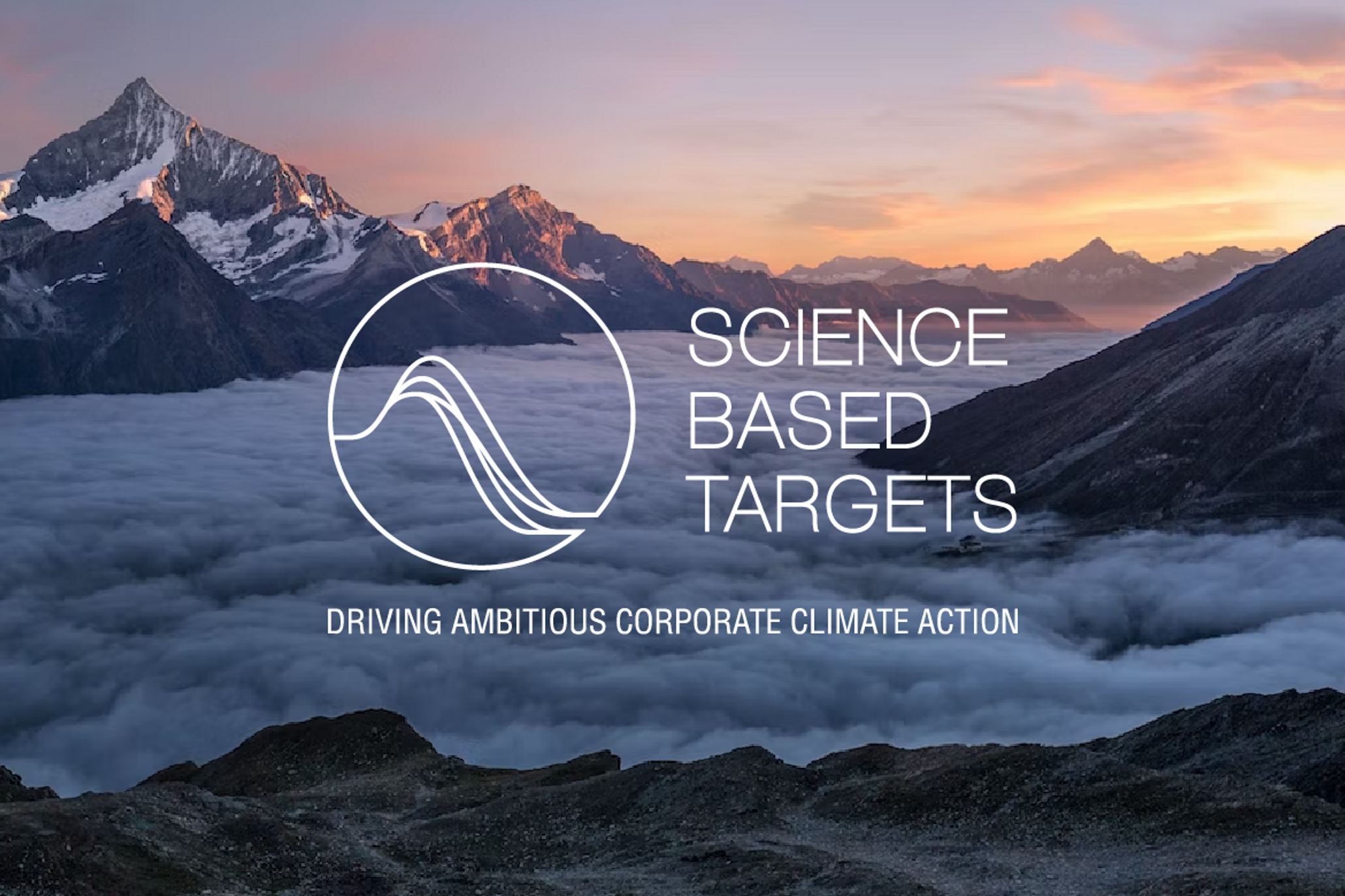A Pivotal Framework for Decarbonisation
In an era defined by the urgent need for climate action, organisations across the globe are increasingly recognising the need to align their business strategies with scientifically grounded sustainability targets.
Enter Science-Based Targets (SBTs) — a pivotal framework that has emerged as a guiding beacon for companies committed to mitigating their carbon footprint and contributing to a sustainable future.
In this article, we embark on a comprehensive journey into the world of Science-Based Target setting, unravelling the significance of this transformative approach in the fight against climate change.
From its inception to its role in reshaping corporate sustainability initiatives, we delve into the core principles of SBTs, exploring how they provide a robust and scientifically rigorous foundation for organisations to set ambitious yet achievable goals in reducing greenhouse gas emissions.
Join us as we explore the methodology behind Science-Based Targets, the sectors that have embraced this transformative framework, and the tangible impacts it has on driving meaningful change.
We will unpack the benefits of aligning business strategies with SBTs, not only in terms of environmental stewardship but also in bolstering resilience, fostering innovation, and enhancing overall corporate credibility.
What is SBTI?
The Science-Based Targets Initiative (SBTi) is a collaborative effort between several organizations, including the Carbon Disclosure Project (CDP), the United Nations Global Compact (UNGC), World Resources Institute (WRI), and the World Wide Fund for Nature (WWF).
The initiative aims to encourage and assist companies in setting ambitious and scientifically rigorous greenhouse gas emissions reduction targets to align with the goals of the Paris Agreement.
The Paris Agreement was a significant milestone in this endeavour, where governments worldwide committed to capping the rise in global temperatures to 2°C above pre-industrial levels.
However, the stakes became even clearer when the Intergovernmental Panel on Climate Change (IPCC) sounded the alarm in 2018, emphasising that the world should strive to limit the temperature increase to a mere 1.5°C.
This more stringent target underscores the critical need for businesses to align their objectives with the 1.5°C trajectory.
Achieving this 1.5°C target demands substantial and timely actions. A pivotal benchmark is the greenhouse gas (GHG) emissions reduction goal set - to reduce emissions by half by the year 2030.
By doing this, the worst effects of climate change can be avoided. But this is just the first step. The journey towards sustainability doesn't end there; the ultimate goal is to attain "net zero" emissions by 2050.
Businesses wield significant influence in shaping sustainable practices. If businesses are to avert the negative impact of unchecked climate change, they need to proactively collaborate with their supply chains to reduce indirect emissions and make a meaningful commitment to climate change.
This is where the Science-Based Target initiative (SBTi) comes in. This initiative offers a structured framework, encouraging businesses to set long-term targets that are both ambitious and credible in terms of emissions reduction.
What does the SBTi do?
- Defines and promotes sustainable practices in science-based emissions reduction targets in line with climate science.
- Provides technical assistance, expert resources, and guidance to companies that set science-based targets in line with the latest climate science.
- Bring together a team of experts to provide companies with independent assessment and validation of targets.
- The SBTi is the lead partner of the Business Ambition for 1.5C campaign - an urgent call to action from a global coalition of UN agencies, and business and industry leaders, mobilising companies to set net-zero science-based targets in line with a 1.5°C future.
Why Should Businesses Strive for Science-Based Objectives?
Governments from around the world agreed in the Paris Agreement to limit global temperature rise to 2°C over pre-industrial levels.
The Intergovernmental Panel on Climate Change (IPCC) issued a warning in 2018 that global temperature must not surpass 1.5°C - hence the urgency for businesses to set 1.5°C-aligned targets.
Participants agreed that in order to reach this target, GHG emissions must be cut in half by 2030 and reach "net zero" (i.e., emissions still being produced are offset by reductions in carbon emissions elsewhere) by 2050.
If the private sector wants to prevent the devastating effects of climate change by limiting the temperature increase and maintain investor confidence over time, businesses need to work with their supply chains and pay attention to the SBTi and set ambitious, credible targets for emissions reduction.
Impact of SBTi
The SBTi, or Science-based Target Initiative, began an era of exponential expansion and rising corporate ambition in 2021, with a tripling of the rate at which new science-based climate targets were validated and a doubling of the number of new organisations setting and committing to set emissions targets.
By the end of 2021, more than 2,200 businesses, accounting for more than a third of the market capitalization of the world's economy, were collaborating with the SBTi, adding more than 110 new businesses each month.
These businesses are setting the standard. But we need every business in every industry, to join them in setting ambitious emission reduction targets. Our planet's future depends on it.
Before COP26, the SBTi Net-Zero Standard was introduced, defining the first framework for corporate net-zero target setting in the world, with 1.5°C-aligned science-based targets as foundations.
What are the Benefits of Science-Based Target Setting?
Universal Recognition
Science-based goals serve as the gold standard for meaningful climate action. It offers a universally acknowledged barometer that aligns over 2,000 private sector companies and financial institutions with the ultimate global environmental target over achieving net-zero emissions.
Catalyst for Innovation
Emissions reduction targets based on scientific research spur innovation and form a long-term company strategy, compelling organizations to innovate, re-evaluate sustainability practices, and prioritise a long-term environmental view.
Strategic Advantage
By proactively aligning with science-based targets, companies can navigate future regulations more effectively, preemptively addressing potential regulatory frameworks related to carbon emissions.
Financial Appeal
Adhering to science-based company targets enhances a company's environmental credibility. Ambitious climate action and proactive sustainability reports appeal to a broader range of investors and financial institutions that are increasingly committed to responsible and sustainable investment practices.
How Can Businesses Establish Science-Based Goals?
Companies should set SBTi-approved emissions-reduction goals that are in line with the most recent scientific findings.
On the route to attaining science-based net-zero targets by 2050, the approach starts by identifying a representative range of emissions scenarios that are deemed realistic, responsible, objective, and consistent with the aim of satisfying the global 1.5–2°C science-based emission reduction target.
The three types of SBTs are short-term, long-term, and net-zero goal objectives.
Short-Term Objectives
These goals take into account how businesses will lower their emissions over the following five to ten years as well as the quick efforts needed to achieve significant emissions reduction goals by 2030. Companies that want to set net-zero ambitions must first have near-term goals.
Long-Term Objectives
This ambitious emissions reductions target shows how businesses will reach net zero in accordance with the requirements of the SBTi's Corporate Net-Zero Standard. To attain net zero, the majority of enterprises will need to reduce emissions by at least 90%.
These goals must be accomplished by 2050 at the latest (2040 for the power sector) to mitigate the worst impacts of climate change.
Net-Zero Objectives
These cover both short-term and long-term objectives. Both short-term and long-term targets have been certified for companies who want to set net-zero targets under the Corporate Net-Zero Standard.
How CoolPlanet Helps with SBTi Goals?
We at CoolPlanet can assist you in the process of reducing your carbon footprint by reducing emissions and energy consumption, as well as setting and achieving ambitious emissions reduction targets.
We can find, design, and implement the best solutions for your business, from increasing energy efficiency and optimising processes to incorporating renewable energy and electrification.
Additionally, we provide you with detailed guidance about funding or scheme possibilities that may benefit your business and make you feel supported during the entire process.
Conclusion
The exploration of Science-Based Targets (SBTs) in our journey to address the pressing climate challenge has revealed not just a framework but a transformative approach that empowers businesses to take meaningful strides toward sustainability.
As organizations increasingly recognise the urgency of aligning strategies with scientifically grounded emissions reduction goals, SBTs emerge as a powerful tool for reshaping corporate sustainability initiatives.
The benefits of adopting SBTs extend beyond mitigating climate crisis, and fostering innovation and resilience.
To delve even deeper into the realms of decarbonisation and net-zero futures, download our comprehensive report, Demystifying Decarbonisation.
As you embark on your decarbonisation journey, consider this: How can your actions today contribute to a more sustainable and resilient future for your organisation?





